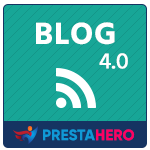How to Customize the Blog Post Listing Page in PrestaShop
The blog post listing page serves as a gateway for visitors to explore your blog content. A well-designed listing page ensures better navigation, enhances user experience and makes your website more engaging. In this guide, we will walk you through the steps to customize the post listing page in the PrestaShop BLOG module.
Step 1: Access the post listing page settings
From the BLOG module's sidebar menu, click on "Post listing page" to open the configuration panel.
Step 2: Configure the post listing page settings
On the post listing page settings panel, you’ll find several options to customize the display:
- Number of posts per page on the main page: Set how many blog posts will be displayed on the main listing page. For example, you can set 6 posts per page to keep the layout clean and readable.
- Number of posts per page on inner pages: Configure the number of posts displayed on paginated inner pages. Adjust this based on your site’s content strategy.
- Sort by: Choose the default sorting order for posts. Options include sorting by date, popularity, or title.
- Display 'Sort by' menu on the post listing page: Enable this to let visitors choose their preferred sorting option directly on the blog page.
- Enable Lazy load effect for blog images: Turn this on to improve page load speed by loading blog images only when they come into the user’s viewport.
- Click on the category image to display full-size image on a slideshow popup: Enable this option to make category images interactive and visually appealing.
Step 3: Save your changes
After configuring the post listing page settings, click Save to apply your changes.
Step 4: Access global slider settings
From the BLOG module’s sidebar menu, navigate to "Global settings" > "Sliders" to configure image sliders for the post listing page.
Step 5: Configure the image slider options
On the Sliders configuration page, customize the image slider with the following options:
- Slider type: Choose between Slick slider (modern, responsive slider) or Nivo slider (classic slider with transitions).
- Autoplay slider: Enable this to let the slider automatically rotate images without user interaction.
- Slide delay time (ms): Set the delay time between slides. For example, 5000ms (5 seconds) provides a smooth experience.
- Display caption: Toggle this to show text captions over slider images, highlighting their context.
- Display control buttons: Add previous/next buttons to let users manually navigate through the slider.
- Display thumbnail images: Show small preview thumbnails below the slider for quick navigation.
- Enable image slider: Turn this on to activate the slider on your blog post listing page.
Step 6: Save your slider configuration
Once the slider settings are configured, click Save to apply the changes.
Customizing the blog post listing page and integrating a slider helps improve your site's usability and visual appeal. Here are some tips for better results:
- Use lazy loading to optimize performance.
- Highlight featured posts using the slider.
- Keep the layout clean by limiting the number of posts per page.
With these changes, your blog post listing page will not only look professional but also provide a better browsing experience for your visitors.

